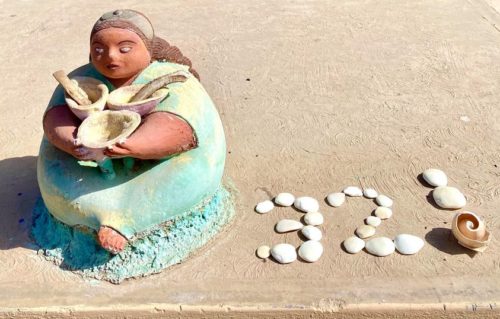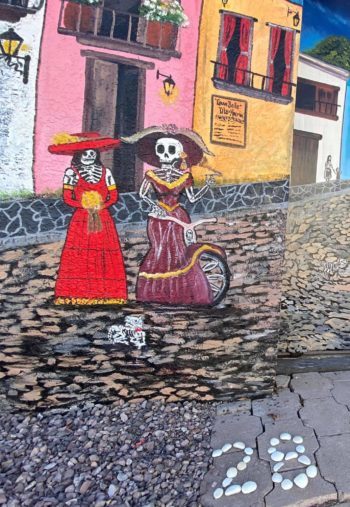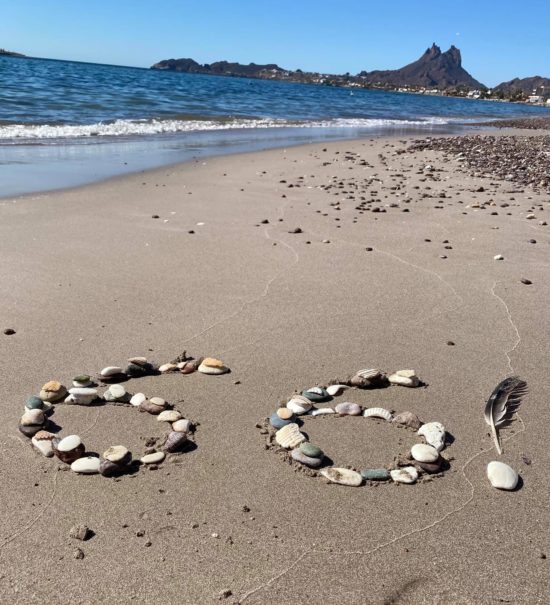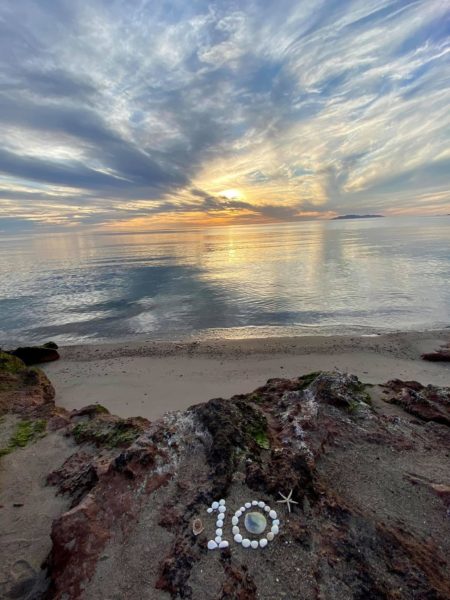EDITOR'S NOTE: Cathy Henkel, a retired newspaper reporter and editor from Seattle, was wintering on the west coast of Mexico when borders closed because of COVID. She turned a hobby of shell-and-stone creations into a daily practice and posted it on Facebook. With just over two months remaining in the presidency of Donald Trump, she began a countdown, installing shells in a variety of settings. Over time, she started reporting the stories of those settings, creating a tour of her world in Mexico. Her project caught our attention for Storyboard when she noted how these daily wanderings helped her rediscover her writing voice.
It’s like a dog that has to be walked. And my dog really had to go.
I haven’t written stories since I was a sports reporter, ending in 1987 when I moved to The Seattle Times to become an editor, closing the door on two decades of writing. So when I say I found joy in rediscovering my voice, I really had to look for it.
At the beginning of the 66-day countdown, the photos ran on their own, as I played with being a visual storyteller. Then came short backstories, and finally short features, maybe 18-20 inches, column length, I’d guess. I’ve got no way of knowing in reality because I’m far from it.

I’ve been isolating for the past 11 months in San Carlos, Mexico, except for the summer in Seattle. I see a handful of people outside, for hikes, for picnics, that sort of thing. I did finally break down a couple of months ago and merged with my Mexican “family” as my pod. Their three little kids are home-schooled and rarely leave home unless biking around the neighborhood. Even their religious service is zoomed. But most of all because they give me love. I couldn’t go through a second winter without contact.
For some reason, books and television, the old reliables, don’t entertain me right now. I knew I needed to get lost in creating. I began on a whim with shell mandalas, eventually populating all five landings of my building and two outside walls, as well as two installations at a friend’s home; they want to sell it and needed some “yard appeal.” I love wandering the beach, collecting the shells, and creating the designs. It’s Zen-like in the moment. I know my creations will disappear when I leave for the summer, via kids and scavengers and then finished off with wind storms that kick the sea onto the wall and wash it clean. It’s ephemeral, but I do have my photographs.
Writing as memory; rewriting as writing
I began the Facebook project to focus on the future by counting backward (to the end of Donald Trump’s presidency). I didn’t want to drown in the daily drama, so I thought why not post some pretty pictures instead? I set my intention on the end of the orange angst and never doubted he would go away on January 20 despite all the shenanigans.
Tour through the countdown photos
Countdown Album #1. Days #66-37.
Countdown Album #2: Days 36-0.
I enjoyed the reporting of local history and art, and discovered that a ballyhooed bandshell in Guaymas, purported to be designed by Eiffel, is probably a fake. Also found out through old crime blogs in Spanish that one of my subjects was once accused of fraud and maybe guilty of worse. But hey, I’m not “60 Minutes.” I’m just writing entertaining snippets. And what successful businessman or woman in Mexico hasn’t been accused of bumping off their partner? (Kidding there. A little.)

And then my mother died from the after-effects of COVID, and I watched on my laptop remotely how an atheist is put to rest. Pretty much, by her own wishes, just open the crypt and slide her in.
The sadness caught me when I visited the beach where I had spread the last of Kent’s ashes years ago. He was a close friend I took care of the last three weeks of his life. That’s when I realized my memory isn’t fading; it was just unbidden.
The more I wrote, the more details gurgled up as I typed each morning before sunrise. I just let it flow; there was no outlining or story form or preplanning. Occasionally, I’d stumble for a word or a phrase and I’d just type “blah blah,” knowing it would come to me later in the rewriting process. Honestly, that little trick is what helped the most in getting back into writing rhythm, and not lose where I was heading.
The real pleasure for me always comes in the rewriting, which frankly even continued for a few hours after I posted each morning because I was a little obsessed. Some days I’d have one lede the first hour, then lop it off the next. It was a wonderfully fluid process, not like writing for print newspapers used to be. And I was writing without a copy desk net; that part I pieced together through friends and the reworking compulsion.
Motivation and inspiration
I cut my teeth as a general assignment reporter in Wichita, Kansas, in my early 20s. I’d go into the newsroom each day, find an assignment tucked in my typewriter, and turn it in a few hours later. A completely new world every morning. Somehow that muscle memory returned almost 50 years later.
At one stage in the countdown, eager for feedback, I talked with a close friend who never hit the “like” button on anything I posted. He said he didn’t like to “like.” It wasn’t personal; he just didn’t like the emoji. He was the veteran police reporter when I was a wide-eyed GA, and we talked about how we got feedback back in the day, before the internet. It must have been the byline, the placement of the story on the page, or a fellow reporter or editor saying, "Good story.” That’s what got me wanting to do it all over again. Because it sure wasn’t the pay.
What I’m getting at is that positive feedback made me stronger. It made me want to write again the next day, funnier, sadder, better, whatever. I started to research the day before instead of going into the writing cold, and that led to a couple of panics when the photo didn’t nudge a story out of me. Rather than toss all night, I took my bag of shells and found another photo that did.
The story about Kent’s final days, fortunately, came toward the end because it absolutely drained me. I went story-less the next day.
Staying open to the stories around you
People have asked why I don’t write a book about my sportswriting days. I have plenty of stories of jostling with athletes in locker rooms, them harassing or mooning me, trying to intimidate — you know the drill. But that seems dated, and not that interesting to draw out other than being anecdotal of the times.

Then I met Lolita here in Mexico through a Spanish conversation group she held each week at her family hacienda. Her family stories were golden, right out of Garcia Marquez, and I thought, I have finally found someone who jumps off the page.
I told several of her stories toward the end of the countdown. I remember hearing them in Spanish first and being gobsmacked by the sadness of her widowed grandmother saying she’d rather her kids had died instead of her husband. One day, nobody else came to the conversation group and she and I were alone for the first time. I asked if she would mind confirming her stories in English, which she spoke well but we rarely heard. So she told me the stories again, and I scribbled it all down. And, of course, when I did write about her in the countdown, my notes were back in Seattle.
But stories like that, you don’t forget. At least I don’t or haven’t yet. It’s part of walking the dog. I have to write to remember. In reworking the stories, I’d edit for cadence, find simple but powerful words, more descriptive or different ones if I had used them before.
Most times, I just had to get out of the way. What is it that we say? These kinds of stories almost write themselves.
Everybody has stories. You just have to listen or find somebody willing to listen to yours.



Cathy Henkel spent 42 years as a newspaper reporter and editor. She was one of the first female sports editors in the country, and one of the longest-serving, in her 20 years at The Seattle Times. She splits her time in retirement between Seattle, Washington, and San Carlos, Sonora, Mexico.



